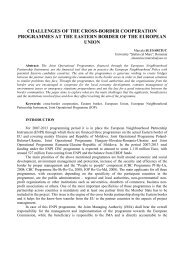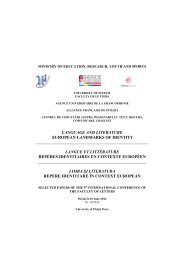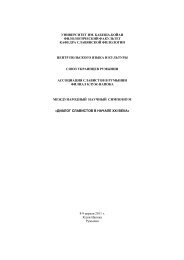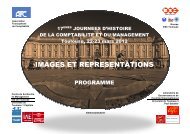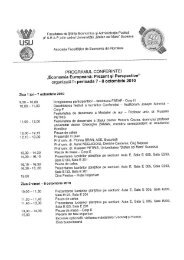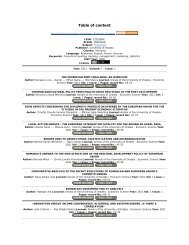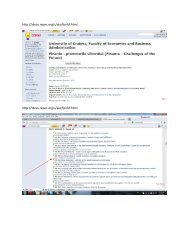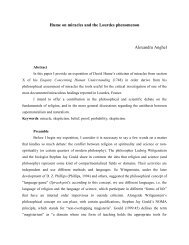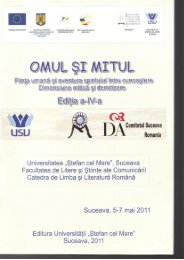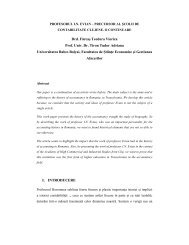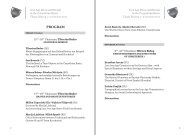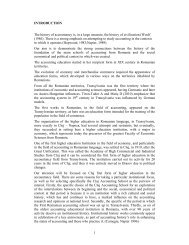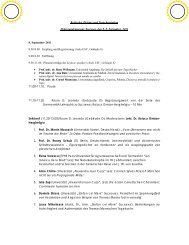- Page 1 and 2: Atelier de Traduction Numéro 16 20
- Page 3 and 4: Atelier de Traduction N° 16, 2011
- Page 5 and 6: SOMMAIRE AVANT-PROPOS Irina Mavrodi
- Page 7 and 8: Jean Poncet (France) - Poèmes de L
- Page 9: AVANT-PROPOS 9
- Page 13: I. ENTRETIEN 13
- Page 16 and 17: Le professeur Michel Ballard a déj
- Page 18 and 19: aurait donc tendance à le coincer
- Page 20 and 21: comprendre le fonctionnement de la
- Page 22 and 23: va déjà dans le sens de ce que vo
- Page 24 and 25: M. C. - Vous avez coordonné un vol
- Page 28 and 29: hégémonique. Cette tâche est ide
- Page 30 and 31: Benjamin propose ainsi une concepti
- Page 32 and 33: autre aire culturelle. Elle est ain
- Page 34 and 35: traduction donne le pressentiment.
- Page 37 and 38: LA TRADUCTION ET LA RETRADUCTION DE
- Page 39 and 40: Qu’on le veuille ou non, la tradu
- Page 41 and 42: vechiu, par exemple, sont remplacé
- Page 43 and 44: des régionalismes et des termes po
- Page 45 and 46: jurisprudence », ordonanţă, « o
- Page 47: Corpus de textes BALZAC, Honoré de
- Page 50 and 51: apparaissent. De ce fait, une retra
- Page 52 and 53: Éd. 1876 Éd. 2010 - fumet (des r
- Page 54 and 55: tellement elles étaient grandes, e
- Page 56 and 57: Changements Lexicaux Traduction de
- Page 58 and 59: imperméable à cet impact de la le
- Page 61 and 62: TRADUCTIONS ET RETRADUCTIONS VERS L
- Page 63 and 64: deux volumes publiés en 1983 et en
- Page 65 and 66: acest » et par un correspondant fa
- Page 67 and 68: « J’ai vécu à Alexandrie d’E
- Page 69 and 70: Morts mes parents…Morts les paren
- Page 71 and 72: Talex inverse l`ordre des mouvement
- Page 73 and 74: Version originale : Panaït Istrati
- Page 75 and 76: S`il avait gardé le terme, on pour
- Page 77:
egistres différents (fait qui ne s
- Page 80 and 81:
mesurer, nous nous arrêterons ici
- Page 82 and 83:
moyen de transmettre le sens profon
- Page 84 and 85:
Synthèse d’une reconstruction ac
- Page 86 and 87:
motivent ses fonctions dramatiques
- Page 88 and 89:
préférence pour la parataxe sur l
- Page 90 and 91:
Une fidélité excessive au texte s
- Page 92 and 93:
fidèle à l’idée d’une traduc
- Page 94 and 95:
“Chi ? Questo bel giovanotto ? Sc
- Page 96 and 97:
NICOLETTI Gianni (sous la direction
- Page 98 and 99:
la pratique de traduire « encore u
- Page 100 and 101:
texte original sous la plume d’un
- Page 102 and 103:
selon Berman, la marque distinctive
- Page 104 and 105:
Ce travail repris à l’infini par
- Page 106 and 107:
épaisseur de sens, s’offrant ain
- Page 108 and 109:
de la première traduction qui donn
- Page 110 and 111:
dimension (selon le DEX casă mică
- Page 112 and 113:
BENSIMON, Paul, (sous la direction)
- Page 114 and 115:
114
- Page 116 and 117:
les peuples. Dans ce contexte, il e
- Page 118 and 119:
Reprenant les analyses faites au su
- Page 120 and 121:
C’est ce que Katharina Reiss dit
- Page 122 and 123:
D’autre part, « les ciblistes»,
- Page 124 and 125:
culturelle. Cette opération ou «
- Page 126 and 127:
126
- Page 128 and 129:
intéressants dès le XIX- ème si
- Page 130 and 131:
Surprenant, travailleur de manufact
- Page 132 and 133:
psychologie des personnages, dont l
- Page 134 and 135:
La version de Lucia Gogan, qu’ell
- Page 136 and 137:
québécois dans l’espace roumain
- Page 138 and 139:
Nous proposons dans la présente é
- Page 140 and 141:
Marcel Duhamel s’avère en effet
- Page 142 and 143:
Ce genre policier s’est vu associ
- Page 144 and 145:
emettent directement en cause la tr
- Page 146 and 147:
polar, p. 34-35. LYOTARD Jean-Fran
- Page 148 and 149:
différemment dans l’espace norm
- Page 150 and 151:
positifs. La préoccupation pour le
- Page 152 and 153:
traduction comporte l’utilité pa
- Page 154 and 155:
eflètent le fonctionnement de pré
- Page 156 and 157:
La question de l’universalité du
- Page 158 and 159:
Le Journal des Sçavans, juillet, 1
- Page 160 and 161:
160
- Page 162 and 163:
que România liberă offrait aux le
- Page 164 and 165:
d’observation et d’investigatio
- Page 166 and 167:
littérature » 23 (Călinescu, 196
- Page 168 and 169:
de chez nous qui est préféré par
- Page 170 and 171:
Sarina Cassvan (1894-1978), traduct
- Page 172 and 173:
« païenne » ; l’intellectuel m
- Page 174 and 175:
laïque du monde, spécifique aux X
- Page 176 and 177:
ationnelle des gens, capable de sou
- Page 178 and 179:
178
- Page 180 and 181:
180
- Page 182 and 183:
SINDROMUL DE PANICĂ ÎN ORAŞUL LU
- Page 184 and 185:
Să revin însă la pactul meu cu g
- Page 186 and 187:
186
- Page 188 and 189:
LEGENDĂ Strălucitoare-n poarta ra
- Page 190 and 191:
PSALM O durere totdeauna mi-a fost
- Page 192 and 193:
ÎN AMINTIREA ŢĂRANULUI ZUGRAV Az
- Page 194 and 195:
PEISAJ TRANSCENDENT Cocoşi apocali
- Page 196 and 197:
196
- Page 198 and 199:
198
- Page 200 and 201:
littéraire est précisément de re
- Page 202 and 203:
Pour le traducteur d’un texte de
- Page 204 and 205:
permanente des textes de pragmatiqu
- Page 206 and 207:
interlocuteur, pour lesquels le rou
- Page 208 and 209:
Bibliographie : BALAŢCHI, Raluca-N
- Page 210 and 211:
210
- Page 212 and 213:
écepteur ; pour qu’il réalise u
- Page 214 and 215:
11. Victor Hugo, Gavroche (2003),
- Page 216 and 217:
[...] traducătorul optează pentru
- Page 218 and 219:
218
- Page 220 and 221:
220
- Page 222 and 223:
été radiographiée dans toutes se
- Page 224 and 225:
224
- Page 226 and 227:
à ses travaux, la Médaille Zaarou
- Page 228 and 229:
Les auteurs français et francophon
- Page 230 and 231:
230
- Page 232 and 233:
anglaises / allemandes / hispanique
- Page 234 and 235:
La thématique proposée pour l’a
- Page 236 and 237:
236
- Page 238 and 239:
238
- Page 240 and 241:
d’une classe hétérogène, qui e
- Page 242 and 243:
exhaustive, dont les conclusions in
- Page 244 and 245:
244
- Page 246 and 247:
L’initiative de traduction est d
- Page 248 and 249:
certains choix peuvent être déter
- Page 250 and 251:
250
- Page 252 and 253:
politique de l’auteur caribéen,
- Page 254 and 255:
d’Henri Michaux et d’Yves Bonne
- Page 256 and 257:
générosité aux études amples, s
- Page 258 and 259:
normative représenterait, dans cet
- Page 260 and 261:
transférés non traduits dans la l
- Page 262 and 263:
Bibliographie : MεTA (Journal des
- Page 264 and 265:
qu’ « en français, on a l’imp
- Page 266 and 267:
Nathalie Vincent-Arnaud fait l’an
- Page 268 and 269:
268
- Page 270 and 271:
l’importance de la connaissance d
- Page 272 and 273:
même temps. Le travail de Paul Mov
- Page 274 and 275:
traduction spécialisée, les aspec
- Page 276 and 277:
où le traducteur réussit à égal
- Page 278 and 279:
Le volume finit par la rubrique Com
- Page 280 and 281:
présente les controverses théoriq
- Page 282 and 283:
5. Le texte est rédigé dans une l
- Page 284 and 285:
Le statut d’un texte donné au se
- Page 286 and 287:
moyens ; cette notion est axée sur
- Page 288 and 289:
BALLARD, Michel - Agrégé d’angl
- Page 290 and 291:
organiser. Le paradoxe de la ponctu
- Page 292 and 293:
allemand, la bande dessinée, le ci
- Page 294 and 295:
suivants : Étude comparative sur l
- Page 296 and 297:
296
- Page 298 and 299:
Vous êtes priés d’envoyer vos p
- Page 300:
300



